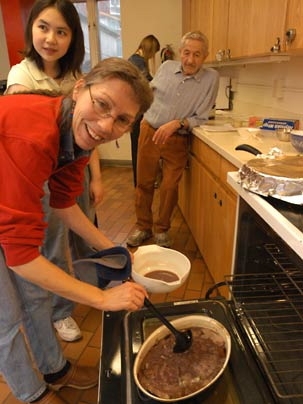Participants in "Old Food: Ancient and Medieval Cooking," a one-session IAP course led by Anne E.C. McCants, associate professor of history and MacVicar Faculty Fellow, "ate exceptionally well," she said.
The mighty food fest, now in its fifth year, filled the kitchen of the Next House dorm with activity from noon to 5 p.m. on Wednesday, Jan. 11.
Howard Eissenstat, lecturer in Middle Eastern history, and Margo Collett, administrative assistant in history, led the session along with McCants.
The jolly crew of 25 enjoyed a medieval meal that included sourdough bread, fresh butter churned right in Next House, roast pork in a strong wine and spice marinade, a green "poree" with spinach and chard, a white "poree" with leek whites and milk; and lasagna with handmade noodles but no sauce, as tomatoes are a New World food.
Dessert was marzipan tartlets and "The Emperor's Magnificent Fritters," made of sweet dough with soft cheese and pine nuts.
According to McCants, the fritters won critics' choice, disappearing in "about three minutes," with the lasagna a close second.
McCants cautioned participants in "Old Food" and in her course on medieval food ways not to equate their experience at Next House's groaning board with ordinary folks' diets in the 16th century. She also tries, she said, to make sure "modern tastes are not offended" by the IAP menu.
Medieval tastes are "too spicy and too sweet. This is because the recipes we have are all elite ones, and do not reflect the boring, bland, often rotten, food eaten by most folks. One way of showing your status was to use expensive things in abundance, especially dried fruits, pepper, nutmeg, cinnamon and ginger. For example, if you followed a 17th century Dutch recipe for what is essentially a gingersnap, you would not be able to stand it," she said.
McCants brings not only her scholarship and enthusiasm to the medieval food fest, but also, some personal history.
The sourdough bread, a staple of the annual MIT event, was made with a starter of yogurt, flour and milk McCants began more than 20 years ago, when she was a graduate student at the University of California at Berkeley.
"I have kept it going all these years, moved it multiple times, and it still has that great San Francisco flavor from the yeast in the air there," McCants said.
To download a PDF file of the recipes used in this event, visit web.mit.edu/history and click on Old Food.






